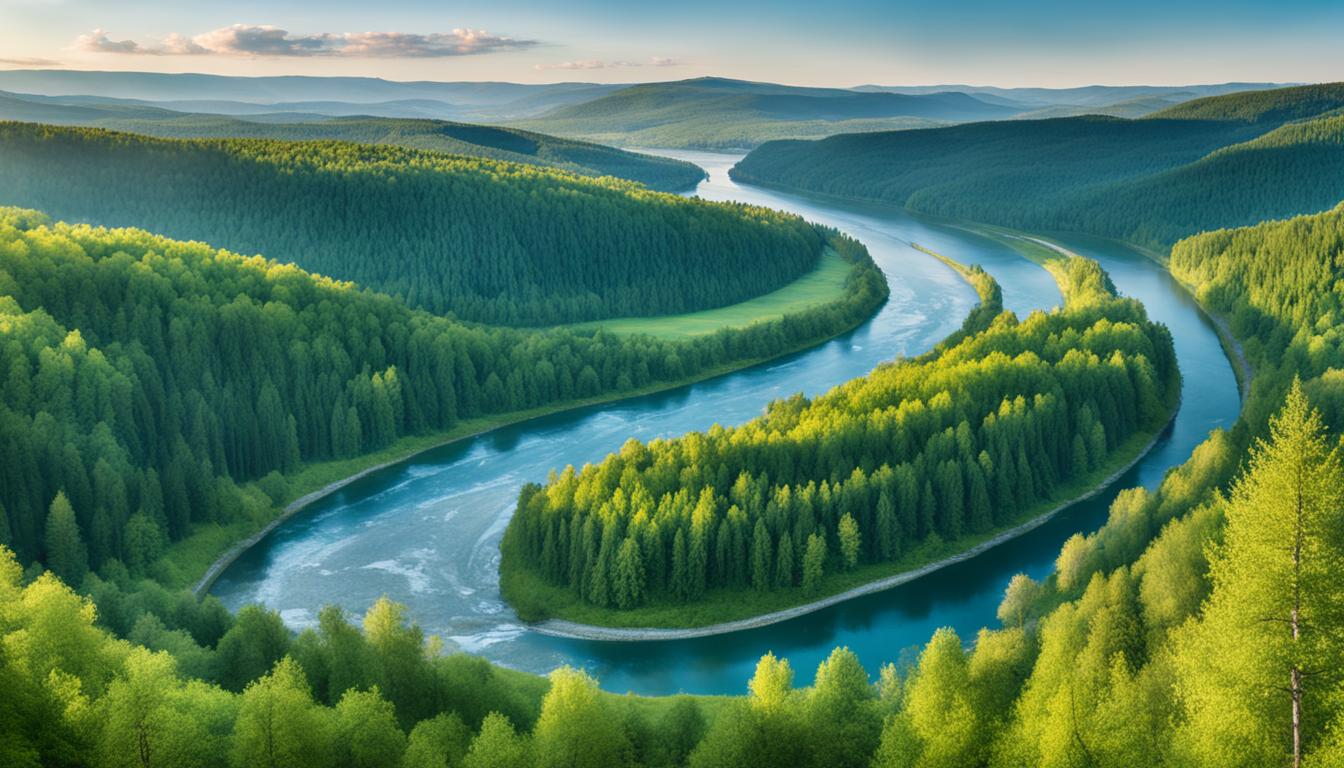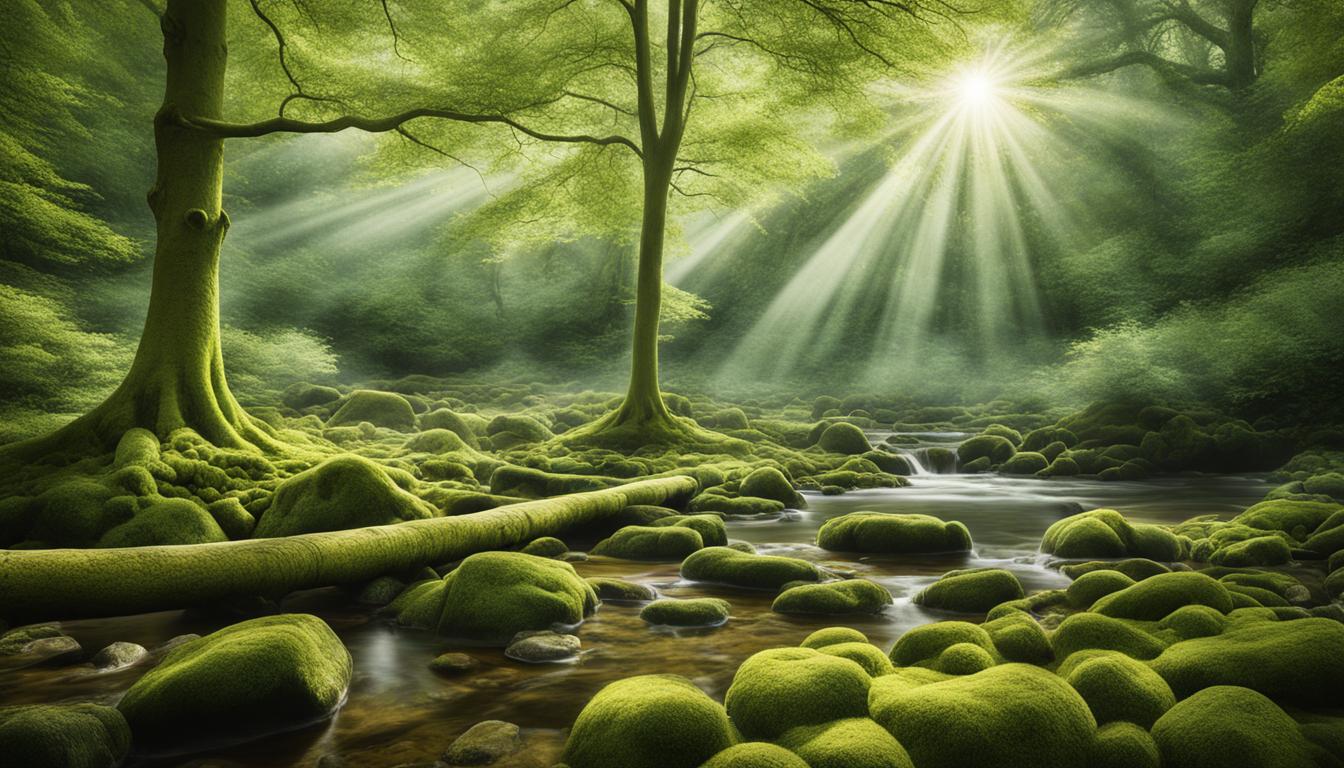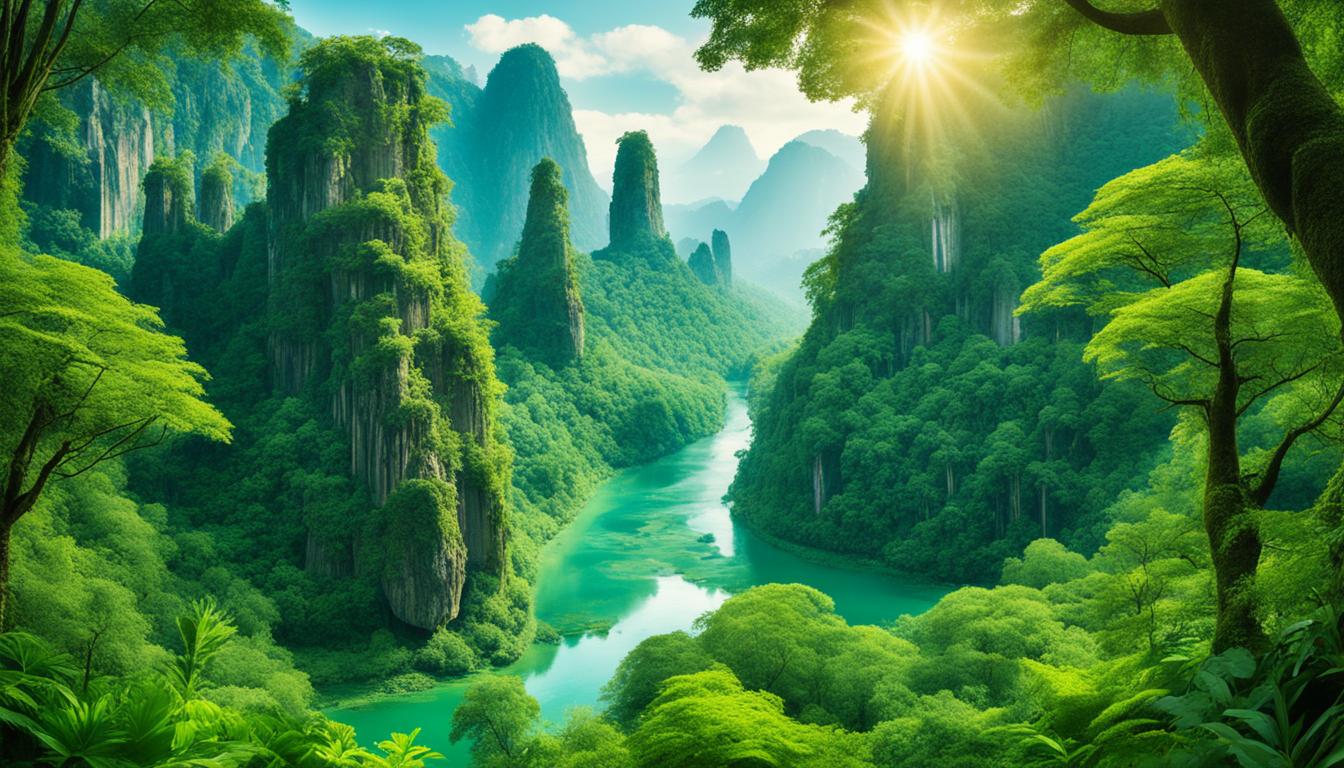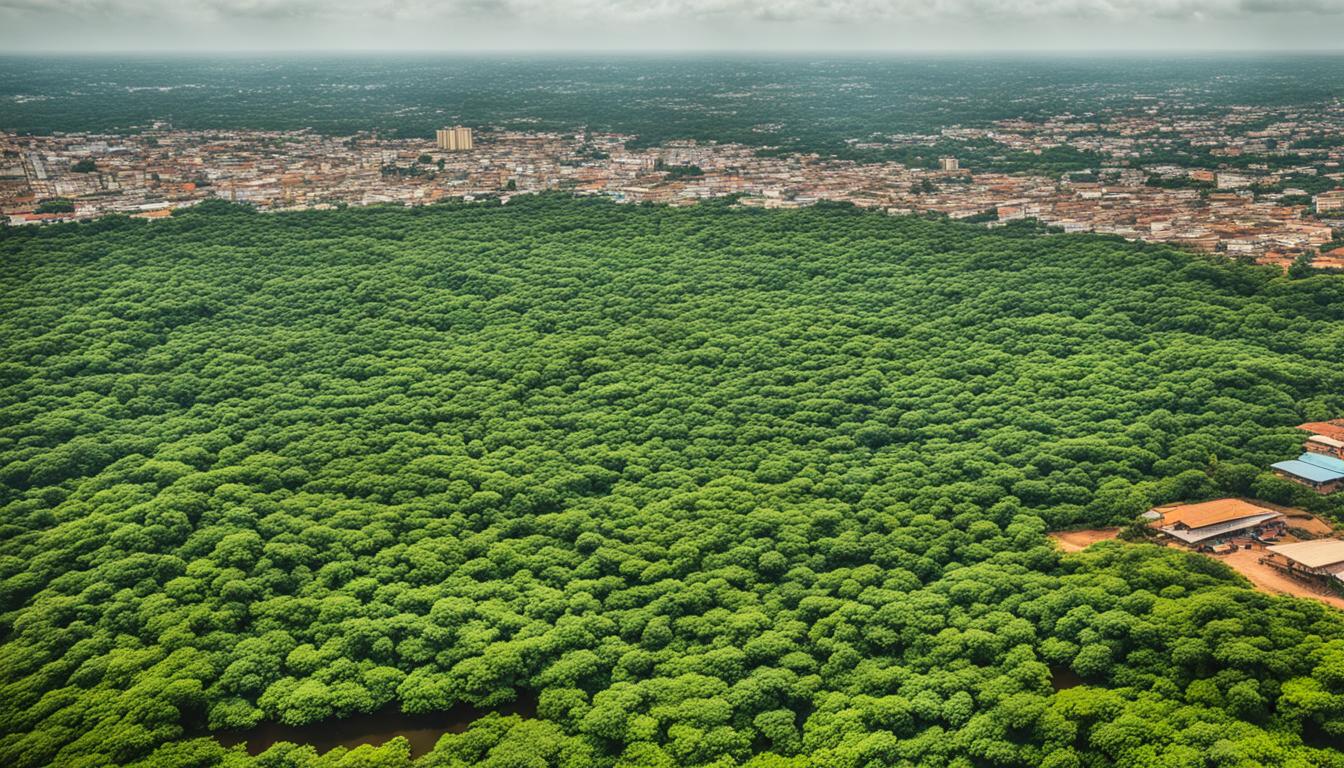United Arab Emirates Sacred Natural Sites and Biodiversity
Did you know that the United Arab Emirates (UAE) is home to over 800 species of plants, 48 species of mammals, 440 species of birds, 72 species of reptiles and amphibians, and more than 40 species of coral reefs? The UAE’s natural landscapes are teeming with unique wildlife, making it a biodiversity hotspot in the region.
However, the UAE’s ecosystems and species face threats from habitat loss, climate change, and invasive species. To protect and preserve its precious biodiversity, the UAE has implemented sustainable development practices, green building techniques, and eco-friendly architecture. Urban biodiversity conservation and sustainable urban planning also play a crucial role in creating harmonious environments.
In this article, we will explore the importance of biodiversity in the UAE, the benefits it provides, and the measures taken to preserve it for a sustainable future.
Key Takeaways:
- The UAE is home to a rich biodiversity, with over 800 species of plants, 48 species of mammals, 440 species of birds, and more.
- Sustainable development practices and eco-friendly architecture are essential for protecting the UAE’s biodiversity.
- Biodiversity in the UAE contributes to various ecosystem services, including food supply, climate regulation, and disease control.
- The UAE has implemented protected areas and conservation programs to preserve its unique ecosystems and cultural heritage.
- Preserving biodiversity is crucial for the UAE’s sustainable development and the well-being of its people.
Importance of Biodiversity in the UAE
Biodiversity plays a vital role in the United Arab Emirates (UAE) and its ecosystems. It supports various ecosystem services that are crucial for human well-being and the proper functioning of the planet.
- Biodiversity ensures a diverse and sustainable food supply by fostering a wide range of plant and animal species that contribute to local cuisine and traditional dishes in the UAE.
- It offers building materials for construction through the utilization of sustainable resources found within the country’s unique ecosystems, promoting eco-friendly architecture and green building techniques in the UAE.
- Biodiversity regulates climate by mitigating greenhouse gases, contributing to climate regulation and mitigating the impacts of climate change in the UAE.
- It promotes soil fertility renewal through the symbiotic relationships between various plant species and microorganisms that enrich and rejuvenate the soil in the UAE.
- Biodiversity controls diseases and pests naturally, providing a natural defense system against harmful parasites and diseases that can affect both humans and ecosystems in the UAE.
- It provides valuable genetic resources for scientific discoveries, supporting research and development efforts in fields such as medicine, biotechnology, and agriculture in the UAE.
- Biodiversity preserves the cultural heritage of the UAE by safeguarding the unique species and ecosystems that hold deep cultural significance and traditions in Emirati society.
By recognizing and preserving the rich biodiversity found in the UAE, the country can achieve sustainable development, ensure a diverse and prosperous future, and protect the well-being of both its people and the environment.
Benefits of Biodiversity in the UAE
The United Arab Emirates (UAE) is a beneficiary of the diverse range of services provided by its rich biodiversity. Biodiversity plays a significant role in supporting sustainable development in the country, offering a wide range of ecosystem services that contribute to the well-being of its people and the environment.
Food Supply
Biodiversity in the UAE ensures a sustainable and diverse food supply. The fertile ecosystems support the growth of different agricultural crops and provide a habitat for pollinators, such as bees and butterflies, which are essential for crop pollination.
Building Materials
The UAE’s biodiversity also provides a source of building materials for construction. Local flora contributes to traditional construction practices, such as the use of palm fronds and mangrove timber, which are environmentally friendly and culturally significant.
Climate Regulation
Biodiversity helps regulate the climate in the UAE by absorbing carbon dioxide, a greenhouse gas responsible for global warming. The country’s diverse ecosystems, including mangroves and desert vegetation, act as carbon sinks, preserving the ecological balance and mitigating the impacts of climate change.
Soil Fertility
The UAE’s biodiversity plays a vital role in maintaining soil fertility. Different plant species enrich the soil with essential nutrients, prevent erosion, and promote soil structure, ensuring the sustainability of agricultural practices and contributing to food security.
Disease Control
The diverse ecosystems in the UAE support natural disease control through the presence of various species that act as natural predators to pests and disease vectors. This reduces the need for chemical pesticides, promoting environmentally friendly agricultural practices.
Genetic Resources
The UAE’s biodiversity provides a wealth of genetic resources that are valuable for scientific and medical advancements. The unique genetic makeup of different species holds significant potential for the development of new medicines, biotechnological innovations, and crop breeding programs.
Cultural Heritage
Biodiversity is deeply intertwined with the cultural heritage of the UAE. Species like the Arab Falcon and camels symbolize nobility and resilience and are integral to Emirati traditions and practices, such as falconry and camel racing. Preserving biodiversity ensures the continuity of these cultural practices and values.
Recognizing and harnessing the benefits of biodiversity is essential for the sustainable development and prosperity of the UAE. By preserving ecosystems, promoting sustainable practices, and integrating biodiversity conservation into decision-making processes, the UAE can secure a bright and sustainable future for its people and the environment.
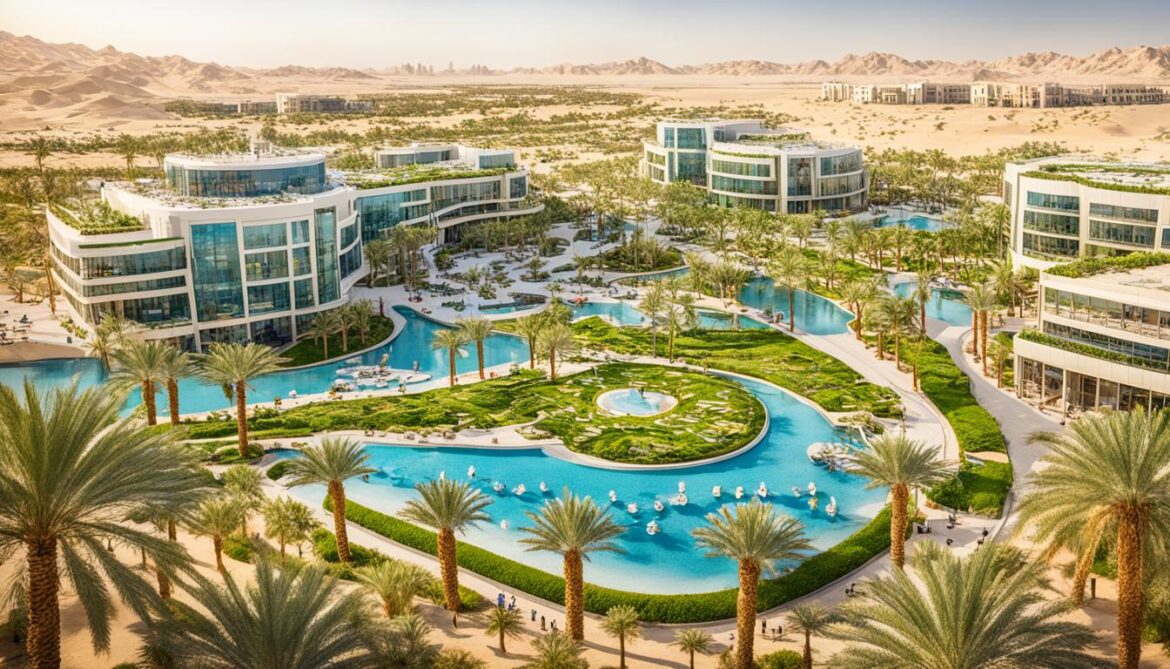
Preserving the UAE’s Biodiversity for a Sustainable Future
The United Arab Emirates (UAE) is committed to the conservation of biodiversity and has implemented various measures to protect and sustain its unique ecosystems. By prioritizing biodiversity conservation and integrating sustainable development practices, the UAE aims to ensure the long-term well-being of its ecosystems, support sustainable economic growth, and preserve its cultural heritage for future generations.
One of the key strategies in biodiversity conservation is the establishment of protected areas, national parks, and wildlife sanctuaries. These areas serve as refuges for a wide range of plant and animal species, providing them with the necessary habitat and protection from human activities. The UAE has designated 22 protected areas, covering a total of 6,841 square kilometers, to safeguard its diverse ecosystems and rare species.
In addition to protected areas, the UAE has implemented various conservation programs that focus on preserving and restoring critical habitats, conducting research and monitoring, raising awareness, and engaging local communities. These programs contribute to the overall goal of biodiversity conservation by promoting sustainable practices and ensuring the effective management of natural resources.
By integrating sustainability into development practices, the UAE strives to balance economic growth with environmental protection. The country is investing in green infrastructure, renewable energy, and sustainable urban planning to minimize the negative impact on ecosystems and promote sustainable living. This approach allows for the coexistence of human activities and biodiversity, ensuring a harmonious relationship between development and nature.
“Preserving the UAE’s biodiversity is not only crucial for the well-being of our ecosystems but also for our future. By protecting our unique flora and fauna, we can sustainably support economic growth, promote ecological balance, and pass down our rich natural heritage to future generations.” – Minister of Environment and Climate Change
Through its commitment to biodiversity conservation and sustainable development, the UAE is actively working towards a sustainable future. By safeguarding its natural heritage and promoting the responsible use of resources, the country is setting an example for global environmental stewardship. It is through these collective efforts that the UAE aims to create a balance between development and the preservation of its precious biodiversity.
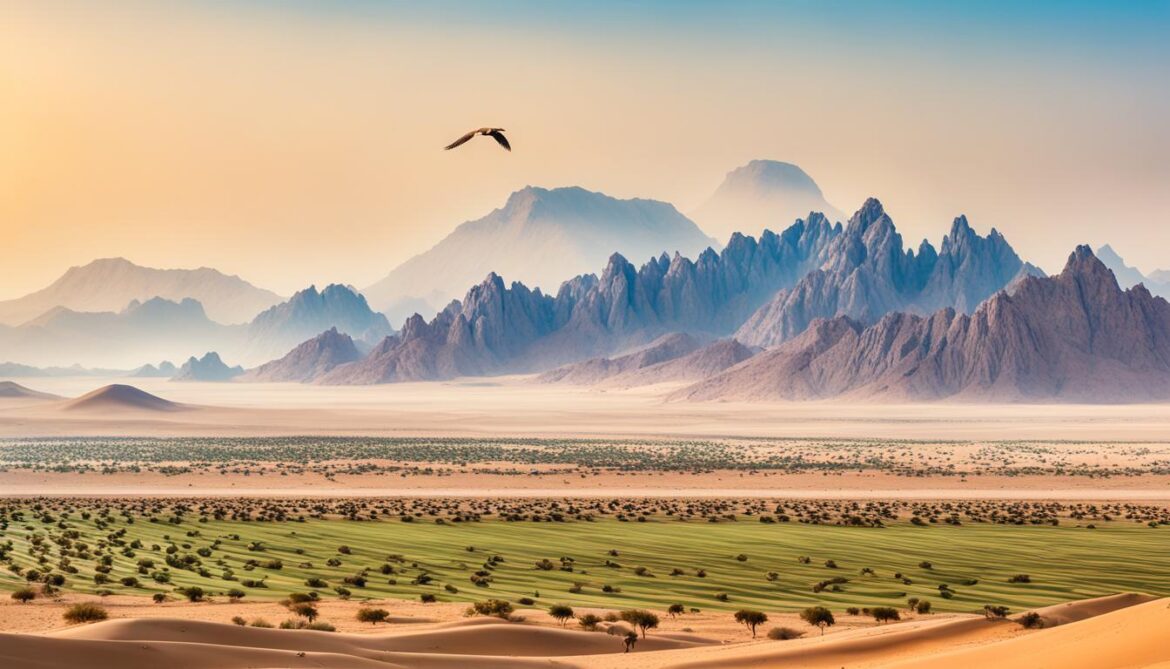
| Efforts for Biodiversity Conservation | Key Initiatives |
|---|---|
| Protected Areas | The UAE has established 22 protected areas to safeguard biodiversity, including the Al Wathba Wetland Reserve, Sir Bani Yas Island, and Dubai Desert Conservation Reserve. |
| Conservation Programs | The UAE has implemented programs such as “Hima” and “Marine Protected Areas” that focus on habitat restoration, species conservation, research, and community engagement. |
| Sustainable Development | The UAE prioritizes sustainability in development practices, promoting green infrastructure, renewable energy, and sustainable urban planning to minimize ecological impact. |
The Value of Biodiversity
Biodiversity plays a critical role in supporting a wide range of ecosystem services that are essential for the well-being of humans and the functioning of our planet. In the United Arab Emirates (UAE), biodiversity contributes significantly to various areas, including:
- Food Supply: The UAE’s diverse flora and fauna support agricultural practices, ensuring a sustainable and diverse food supply for the population.
- Building Materials: The rich biodiversity in the UAE provides a variety of natural resources necessary for traditional construction practices and the development of sustainable infrastructure.
- Climate Regulation: Biodiversity helps regulate the climate by absorbing carbon dioxide, mitigating greenhouse gas emissions, and maintaining temperature balance.
- Soil Fertility Renewal: Flora and fauna play a crucial role in nutrient cycling, soil formation, and the maintenance of healthy and fertile soils.
- Disease Control: Biodiversity acts as a natural control mechanism for pests and diseases, reducing the reliance on synthetic chemicals and promoting ecological balance.
- Genetic Resources: The UAE’s diverse ecosystems provide a vast array of genetic resources with potential applications in medicine, agriculture, and other scientific fields.
- Cultural Heritage Preservation: The unique biodiversity of the UAE is deeply intertwined with the cultural practices and values of its people, contributing to the preservation of cultural heritage.
Biodiversity is not just about the number of species, but also about the invaluable ecosystem services it provides. It plays a fundamental role in sustaining human life and fostering the UAE’s sustainable development efforts by supporting vital sectors such as agriculture, construction, climate regulation, disease control, and cultural heritage preservation. Recognizing and preserving the value of biodiversity is crucial for the UAE’s prosperity and the well-being of its people.
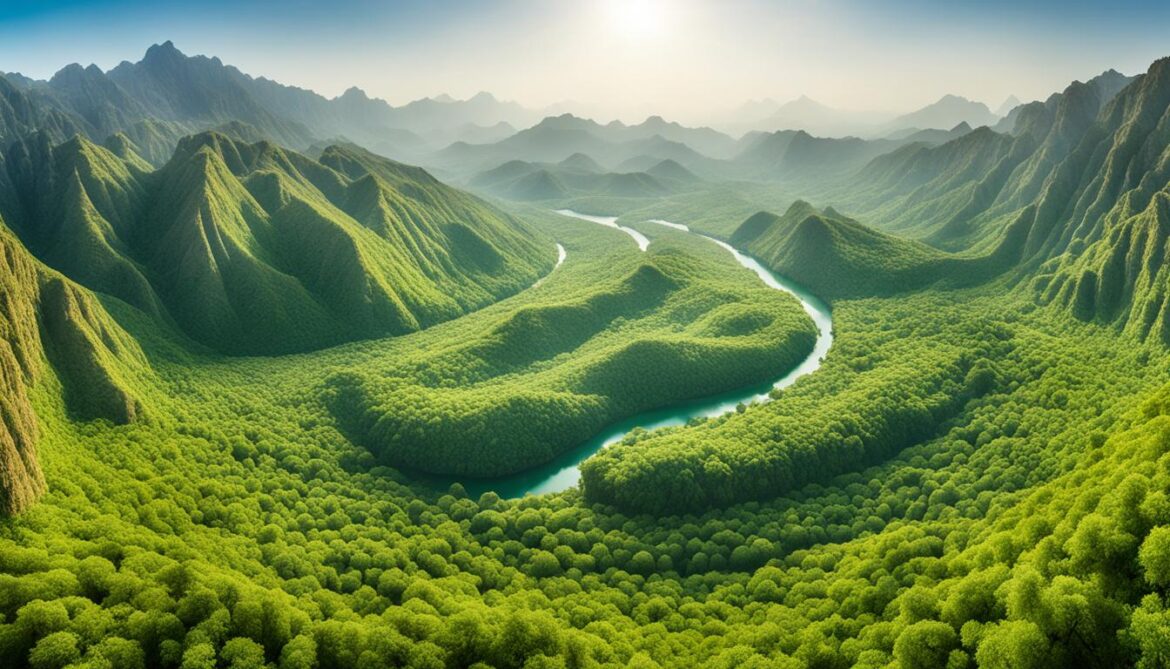
Cultural Significance of Biodiversity in the UAE
Biodiversity holds great cultural significance in the United Arab Emirates (UAE). Species like the Arab Falcon and camels are deeply intertwined with Emirati culture and symbolize strength, nobility, resilience, and companionship. The Arab Falcon represents power, grace, and agility, and the practice of falconry is a cherished cultural heritage. Camels have played a vital role in Emirati history and daily lives, serving as transportation and sources of milk.
The cultural significance of biodiversity extends beyond individual species and encompasses the traditional practices and values that have shaped Emirati identity for centuries. The bond between the Emirati people and these iconic species reflects a deep respect for nature and the interconnectedness of humans and their natural surroundings. By conserving biodiversity, the UAE preserves its cultural heritage and ensures the continuation of traditional practices for future generations.
Preserving Traditional Practices
The conservation of the Arab Falcon and camels is not solely for their intrinsic value but also for their cultural importance. The practice of falconry is deeply rooted in Emirati heritage, representing a longstanding tradition of falcon breeding, training, and hunting. This ancient art is passed down through generations, strengthening familial bonds and promoting cultural cohesion.
In a similar vein, camels hold a special place in Emirati hearts. They have been integral to desert life, facilitating trade routes, providing transportation across the rugged terrain, and offering sustenance through their milk. The enduring presence of camels in Emirati culture is evident in traditional celebrations, such as camel races and beauty contests.
“The Arab Falcon and camels are not just animals; they embody a way of life and reflect the wisdom, resilience, and resourcefulness of the Emirati people.”
Nature’s Teachings
The Arab Falcon and camels embody values that are deeply ingrained in Emirati culture. The falcon’s power, grace, and agility serve as metaphors for strength, determination, and adaptability. They remind the Emirati people to embrace these qualities in their own lives.
Camels, on the other hand, are symbols of resilience and companionship. Their ability to thrive in harsh desert conditions teaches valuable lessons about resourcefulness, endurance, and the importance of community support.
Preserving Emirati Identity
Conserving biodiversity in the UAE is not just about protecting individual species; it is about preserving the cultural identity of the Emirati people. The Arab Falcon and camels are symbols of Emirati heritage, cherished for their symbolic significance as well as their practical contributions to Emirati society.
By actively working to protect and preserve the species that hold cultural significance, the UAE safeguards its cultural heritage and ensures that the traditional practices, values, and stories associated with these species continue to be passed on from one generation to the next.
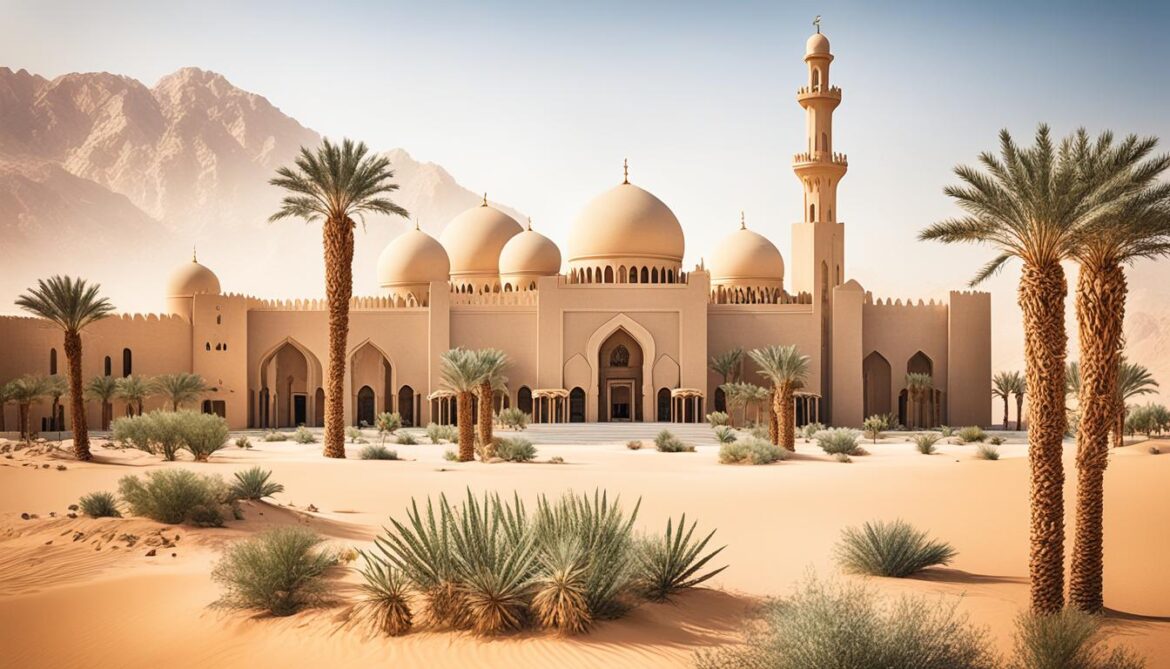
The Arab Falcon and camels represent the rich cultural fabric of the UAE, inspiring pride and reverence among the Emirati people. Preserving biodiversity is not only a matter of environmental conservation but also a means of safeguarding the intangible heritage that shapes Emirati identity. Through conservation efforts, the UAE ensures that future generations will continue to cherish and honor the important role these species play in their cultural heritage.
UAE’s Biodiversity Facts
The United Arab Emirates (UAE) is home to a unique environment comprised of three major ecosystems: desert, mountain, and coastal. Despite the hot and arid climate, the UAE boasts a relatively rich fauna and flora, thanks to its strategic location as a convergence point between the Indo-Asian and Afro-European regions.
The UAE harbors a diverse range of plant and animal species. With 731 plant species, 48 mammal species, 440 bird species, 40 varieties of coral reefs, 500 fish species, and numerous other marine species, the country’s biodiversity is striking. These ecosystems support a wealth of life, even in challenging conditions.
The UAE has taken significant steps to protect its natural heritage. The country has designated 22 protected areas, covering a total area of 6,841 square kilometers. These protected areas, some of which are listed under the Ramsar Convention, serve as sanctuaries for various species and habitats.

The unique biodiversity of the UAE’s desert ecosystem showcases the remarkable resilience of life in challenging conditions. This ecosystem hosts a variety of plant species, such as succulents, desert shrubs, and hardy grasses, which have adapted to survive in the arid environment.
In the mountainous regions of the UAE, the diverse ecosystem supports a range of flora and fauna. High-altitude plants, including junipers and wildflowers, thrive in cooler and more temperate conditions. The mountains are also home to mammal species like Arabian tahr and caracals.
The coastal ecosystem of the UAE is a vibrant hub of marine biodiversity. It encompasses expansive seagrass meadows, mangrove forests, and coral reefs. These habitats provide essential breeding grounds and nurseries for various marine species, supporting the entire coastal food chain.
| Ecosystem | Number of Plant Species | Number of Animal Species |
|---|---|---|
| Desert | 365 | 60 |
| Mountain | 276 | 115 |
| Coastal | 90 | 265 |
The UAE’s biodiversity is a testament to the country’s commitment to environmental conservation. By protecting its unique ecosystems and species, the UAE ensures the long-term health of its natural heritage for future generations.
Main Pressures on and Drivers of Change to Biodiversity in the UAE
The United Arab Emirates (UAE) is facing various pressures and drivers of change that are significantly impacting its rich biodiversity. These factors include invasive alien species, climate change, overgrazing, overuse of marine resources, water desalination, wastewater, and tourism. Let’s explore each of these pressures in more detail:
Invasive Alien Species
Invasive alien species pose a significant threat to native ecosystems in the UAE. These non-native species compete with indigenous flora and fauna for resources, disrupt ecological balance, and can even lead to the extinction of native species.
Climate Change
Climate change is altering the distribution and behavior of species in the UAE. Rising temperatures, changing rainfall patterns, and extreme weather events adversely affect the survival and reproductive capabilities of many organisms. (https://tesseraonlaketravis.com/) This disruption can result in shifts in habitat suitability and the loss of biodiversity.
Overgrazing
Overgrazing, especially in arid regions, has a detrimental impact on the UAE’s biodiversity. Uncontrolled grazing activities by livestock can lead to habitat degradation, soil erosion, and the destruction of plant communities. This, in turn, reduces food sources and disrupts entire ecosystems.
Overuse of Marine Resources
The UAE’s coastal ecosystems are under pressure from the overuse of marine resources. Overfishing, destructive fishing practices, and indiscriminate harvesting of marine life can lead to a decline in fish stocks, damage coral reefs, and negatively impact other marine organisms.
Water Desalination
Water desalination, while essential for meeting the UAE’s freshwater needs, has unintended consequences for biodiversity. The discharge of concentrated brine and chemicals from desalination plants can harm marine ecosystems and affect the survival of marine species.
Wastewater
The improper management of wastewater can have a significant impact on the UAE’s biodiversity. Untreated or poorly treated wastewater that is discharged into water bodies can lead to water pollution, oxygen depletion, and the growth of harmful algal blooms, negatively affecting aquatic organisms and ecosystems.
Tourism
The growth of tourism in the UAE, while bringing economic benefits, can also place pressure on fragile ecosystems. Increased human activity, infrastructure development, and visitor behavior can result in habitat disturbance, pollution, and the degradation of natural areas.
Addressing these pressures and drivers of change is essential to ensure the conservation and sustainability of the UAE’s biodiversity. By implementing effective management strategies, promoting sustainable practices, and raising awareness among stakeholders, the UAE can strive towards a future where its unique ecosystems and species are protected and thrive.
Measures to Enhance Implementation of the Convention
The United Arab Emirates (UAE) is committed to enhancing the implementation of biodiversity conservation through a range of measures. One significant step taken by the UAE is the development of its first Biodiversity Strategy (2014-2021), which encompasses national goals and action plans aligned with sustainable development objectives.
The biodiversity strategy UAE focuses on mainstreaming biodiversity in economic and social sectors, promoting knowledge sharing, upgrading biodiversity management, protecting habitats, reducing pressure on biodiversity, and enhancing cooperation among stakeholders.
Legislation has been implemented in the UAE to further support biodiversity conservation efforts. Additionally, mainstreaming strategies and capacity-building initiatives are being carried out to ensure a comprehensive and integrated approach to conservation.
By monitoring, assessing, and reporting progress, the UAE is determined to achieve its conservation goals and safeguard its unique biodiversity for future generations.
The UAE’s commitment to protected areas is also evident. The country has established a network of protected areas, including national parks and wildlife sanctuaries, that play a critical role in preserving the nation’s ecological treasures.
Moreover, the UAE has implemented various conservation programs to address specific environmental challenges and protect vulnerable species. These programs focus on habitat restoration, species reintroduction, and sustainable use of resources.
Promoting Collaboration and Partnerships
Recognizing the importance of collective action, the UAE actively collaborates with international organizations, governmental agencies, and local communities to enhance biodiversity conservation. By forging partnerships, the UAE gains access to expertise, resources, and knowledge exchange, strengthening its conservation efforts.
Through these inclusive measures, the UAE is working towards the sustainable management and preservation of its rich biodiversity, ensuring a harmonious coexistence between nature and societal development.
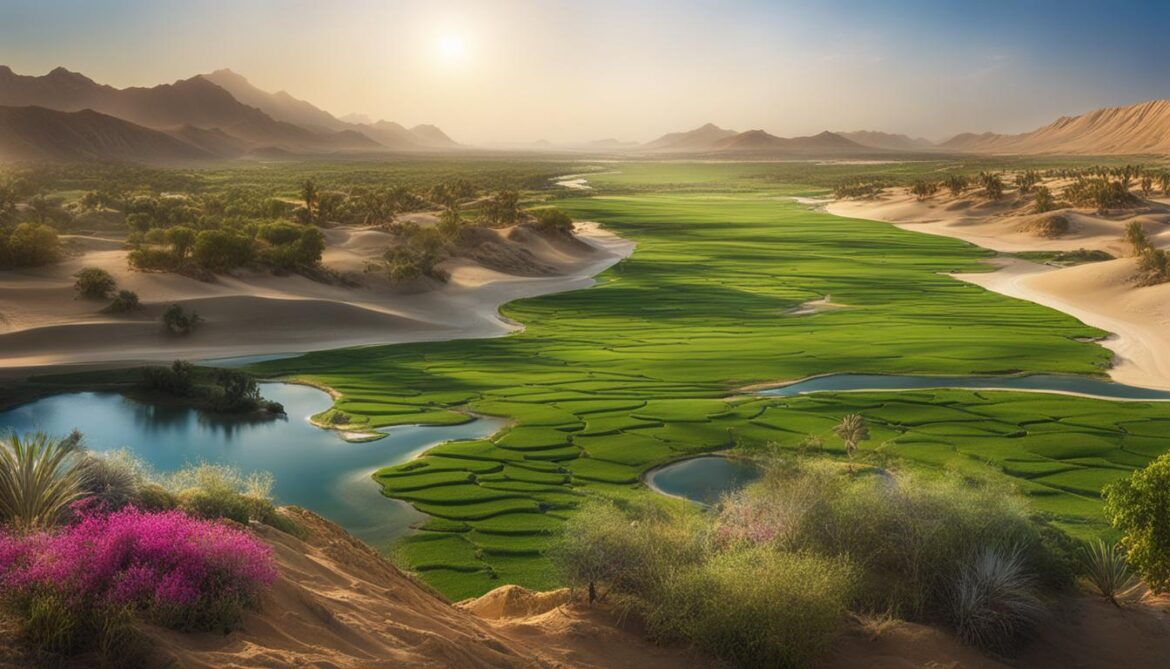
| Program/Initiative | Focus |
|---|---|
| National Biodiversity Strategy (2014-2021) | Mainstreaming biodiversity, upgrading management, protecting habitats |
| Protected Areas Network | Preserving ecosystems and critical habitats |
| Habitat Restoration Programs | Restoring degraded habitats and enhancing biodiversity |
| Species Reintroduction Initiatives | Reintroducing threatened species to their natural habitats |
| Sustainable Resource Use Projects | Promoting sustainable practices for resource utilization |
Conclusion
The United Arab Emirates (UAE) is committed to the conservation of its biodiversity and the pursuit of a sustainable future. By implementing protected areas, investing in conservation programs, and adopting sustainable development practices, the UAE aims to preserve its unique ecosystems and cultural heritage. Through valuing and utilizing the benefits of biodiversity, the UAE can foster sustainable economic growth while ensuring the well-being of its people and the environment. This dedication to biodiversity conservation is essential for creating a harmonious and prosperous future for the nation.




